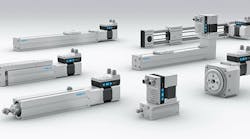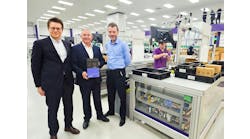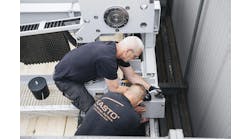Ease of use for operation, design and installation dominate trends for motor and drives, guided by vast component integration and user-friendly configuration tools. While most motors and drives are small and efficient these days, manufacturers continue to innovate with new technology for smart actuators, embedded safety features, high torque-to-weight ratios, integration modules between controller and motor, seamless connectivity, peer-to-peer communications protocol, and hybrid communication and power cables. Six manufacturers—Festo, Kollmorgen, Allied Motion Technologies, Nidec, Moog and Bosch Rexroth—discuss their latest designs for moving from pneumatic to electromagnetic actuation, drive-resident safety, outer-rotor brushless motors, drag-and-drop configuration, extra low voltage servo drives and cabinet-free technology.
Smart actuators
Eric Rice, product market manager at Festo, says the motor and drive market is tasking OEM machine builders to develop smaller, faster and smarter machines. “Along with those requirements, the development time for new machinery is becoming compressed as end users expect to implement new designs in a matter of months instead of years,” Rice says. Festo offers the Simplified Motion Series (SMS) to help plants make the conversion from pneumatic to electric actuation as easy as possible.
“SMS is a line of smart actuators that were designed from the ground up to be easy to use,” Rice says. “The technology behind this solution is the embedded software that controls each axis and presents the motion of the axis to the operator in a simplified way, making the product incredibly easy to commission on the machine.” The first SMS actuators were launched in late 2019, with more released in 2020. The line includes seven base actuator designs. The linear actuators include options for cantilever (rod-type) and rodless actuators, driven by screw or bolt, with stroke length available between 5 and 2,000 mm.
Rice says SMS electric actuators have been used in positioning, indexing, clamping, feeding and cut-to-length tasks. “This new solution, for example, extends low-cost simple motion to medical lab equipment and operations in clean and sanitary environments,” Rice says. An important reason to switch from pneumatic to electric actuation, he says, is when more than two or three stop positions are required along the stroke of the actuator (Figure 1). “Electric actuators excel in this area because they can be positioned to a practically unlimited number of stops,” Rice says. Multiple stops can be achieved with pneumatic actuators, but it increases the cost and complexity dramatically, he added.
“Another reason to use electric instead of pneumatic is when compressed air is either not available or too expensive,” Rice says. “End users who are trying to manage energy consumption for their plants may find that maintaining compressed air increases the total cost of ownership of their machinery. As a result, many end users are restricting the use of compressed air, especially on new machines.” Rice says electric axes are very good at both positioning and force/torque control in the same motion profile, and they are energy efficient and their energy consumption is load-dependent.
Most programmable motor drives, Rice says, require the operator to use a computer and a proprietary software application to configure the drive. “This requires downloading and installing the application software, connecting the computer to the motor drive with a programming cable, and writing the configuration parameters to the drive’s nonvolatile memory,” Rice says. “With SMS, this entire process can be eliminated. No computer is required to configure an SMS axis because the motion software is embedded in the motor drive and transparent to the user.” Operators can perform all configurations—end positions, motor speed and motor torque—directly at the axis through the operator interface.
In general, pneumatic actuators have a simple setup, while conventional electromechanical actuators typically require specialized personnel for installation. “The higher level of technical skill required to commission a conventional servo axis is not needed to commission an SMS axis,” Rice says. Sizing is supported by Festo’s online tool, Solution Finder, which allows end users to simply enter their motion, load and axis orientation requirements. The Solution Finder provides a list of options to choose from with the most economical solution listed first, Rice says.
“SMS is specifically designed for point-to-point positioning between two end stops, with the ability to accurately and gently move into position and an option to control force for simplified pressing and clamping operations,” Rice says. “SMS was created to bridge the technology and knowledge gap between pneumatic and electromagnetic actuation by providing a system that is easy to install while being accurate, programmable and energy efficient.”
Figure 2: Kollmorgen’s servo drive, AKD2G, features SafeMotion safety functions that are designed for simple implementation and reduce latency, response times and wiring complexity.
Safety integration
Many customers are looking for drive-resident safety features, says Will Hulbert, product line manager at Kollmorgen. “Safety functions have become integral to making machines that meet higher safety protection requirements up to SIL3/Ple. By integrating safety features in the drive, suppliers make it easier for machine builders to navigate what can be a complex and expensive process,” Hulbert says. Kollmorgen’s latest generation of servo drives, AKD2G, is part of the company’s complete 2G Motion System and features drive-resident SafeMotion safety functions that are designed for simple implementation and reduced latency, response times and wiring complexity (Figure 2), Hulbert says. The ADK2G servo drive was launched in 2018 as part of the 2G Motion System, and AKD2G SafeMotion was launched in 2020.
“With the safety functions drive-resident the inputs for safety actions and the outputs—response that the drive creates, for example, changing motor direction, speed or stopping the motor—takes place on the same hardware,” Hulbert says. “By not having to wire to separate devices and then wire those devices together, overall wiring can be reduced. The extra time that is needed for different devices to receive, process and output responses is reduced or eliminated, meaning lower latency and faster response time.”
Ideal applications for the AKD2G servo drive include food and beverage processing, material handling, metal/material forming and packing and converting machinery. Hulbert says the dual-axis drive offers twice the power density over a single axis drive and takes up 20% less space than traditional technology. The servo drive is a TÜV-certified function safety solution. “TÜV (Technischer Überwachungsverein) is an independent certifying body that reviews the design and manufacturing processes for, in this case, products that are intended to meet IEC and ISO machinery functional safety standards,” Hulbert says. This can help machine builders simplify the risk-assessment process.
AKD2G also features SafeMotion Monitor (SMM), which offers users three distinct levels of safety functionality in the same drive package. Functional Safety (FS) 1 includes safe torque off (STO) for capability up to SIL2/PLe. FS2 builds on FS1 by adding functional safety over EtherCAT (FSoE) and SafeStop functions for capability up to SIL3/PLe. FS3 expands FS2 with safe speed and positioning functions, maintaining capability up to SIL3/PLe. SMM includes the full range of ISO-certified SafeStop, SafeSpeed and SafePosition options. SafeStop includes four functions: safe torque off, safe stop-time monitored, safe brake control/safe brake test (SBC/SBT) and safe dynamic brake (SBD). SafeSpeed and SafePosition include 12 functions: deceleration monitored SS1 (SS1-r), safe stop 2 (SS2), safe operating stop (SOS), safe limited speed (SLS), safe speed range (SSR), safe speed monitor (SSM), safe direction (SDI), safe acceleration range (SAR), safe limited acceleration (SLA), safe limited increments (SLI), safe limited position (SLP) and safe cam (SCA). “It is important to remember that functional safety provides an array of possible responses not just stopping the machine, so we want to identify and respond as rapidly as possible, but the specific response may differ by the nature of the application,” Hulbert says.
Simple implementation is key for this servo. “With the functions being drive resident, it is not necessary to work within a separate setup software tool. The same software that is used to set up standard drive functions is also used to set up the safety functions. With a single software environment for the drive functions, the learning process is simpler and faster,” Hulbert says. “The time to implement is reduced as switching software is not needed and all the coordination between the drive’s operational and safety functions is managed within that one software environment.”
The ADK2G drive is available in a base model and an expanded I/O variant that increases I/O count by 12 to a total of 28. “The expanded I/O variant makes internal changes to provide the additional I/O through the front of the enclosure connectors. These internal changes do not require an increase in the external enclosure size. I/O can be expanded further using network-connected I/O on FSoE to accommodate large I/O counts or specialized I/O types,” Hulbert says.
With a removable memory SD card, users can store and transfer from one drive to another by moving the card. “This can be helpful for setup and configuration of multiple devices or machines, to replace a drive or for troubleshooting a machine,” Hulbert says.
Figure 3: Allied Motion’s KinetiMax High Power Density (HPD) motor has a high efficiency rating and power-to-weight ratio.
Outside the stator
Particularly in medical and robotics applications, the need for highly efficient motor parts that deliver power on demand, in the smallest design possible, will continue to grow, says Michael Wright of Allied Motion Technologies. Allied Motion’s KinetiMax High Power Density (HPD) motor, part of the KinetiMax series of precision outer-rotor brushless motors with integrated drive electronics, is designed for high-torque, low-cogging applications like robotics, autonomous guided vehicles (AGVs) and hand-held power tools. Wright says that the HPD motor has an efficiency rating of more than 85% and a high power-to-weight ratio, making it ideal for applications where weight and battery life are critical (Figure 3).
Launched in 2019, the KinetiMax HPD series is offered in compact stator-rotor sets. They are available in six frame sizes, with three stack-lengths per size and three windings per stack length. “The HPD series also features a large stator bore that allows cabling to easily pass through for applications such as robotic joints,” Wright says. The KinetiMax HPD is also designed for applications with medical equipment, hand-held hydraulic tools, material handling systems, rotary actuators and gimbals. Space-constrained applications where total motor length is crucial will benefit from this compact kit motor, Wrights adds.
In pump applications, the motor’s higher inertia helps with torque variations. “Piston and membrane pumps have a typical pulsating load torque when driven. The higher inertia of the rotor takes care of that,” Wright says.
Outer-rotor brushless DC motors differ from typical brushless DC motors because the rotor revolves around the outside of the stator (Figure 3), Wright explains. “The rotor is basically a steel cup with permanent magnet segments on its inside,” he says. “The laminated core, multiphase stator is coupled to a controller board, and this assembly is fixed to the housing of the motor.” Outer-rotor motors tend to have a higher torque rating compared to inner-rotor motors with the same diameter and length, especially for applications where motor length is critical, he adds.
The large airgap radius, compared to an inner-rotor motor, boosts the output torque, Wright says, and the magnetic design minimizes cogging by its choice of the number of teeth, number of poles and magnet dimensions.
The KinetiMax HPD offers a variety of options, such as temperature sensors, Hall commutation board and aluminum mounting ring. “This type of stator/rotor is often used up to its thermal limits. To do this in a safe way, a thermal sensor can measure the winding temperature to protect it against overheating,” Wright says.
The motor has high torque-to-weight ratios, very short motor lengths and superior energy efficiency, Wright says. “The efficiency is calculated by dividing output power by the input power. The power that goes into the stator/rotor is electrical power and what comes out as mechanical power is torque at a certain speed. We measure the electrical input power with a power analyzer. Output power is calculated by multiplying the measured torque by a torque sensor and the rotor speed,” Wright says.
No coding configuration
Figure 4: The PowerTools integration module PTi210 co-processor motion controller module includes configuration software to simplify the setup process.
Users are looking for more components with user-friendly configuration, including simple drag-and-drop and drop-down menus and entry fields, in pursuit of reducing development time, says Mike Wolfe, business development manager at Nidec. The PowerTools integration module PTi210 co-processor motion controller module provides an easy-to-use software interface. When attached to the Control Techniques Digitax HD and Unidrive M servo drives, it reduces development time with no coding to set up simple or complex motion profiles, Wolfe says. Launched in November 2020, Wolfe says the PTi210 is the culmination of nearly 30 years of software and hardware development.
The PowerTools Studio configuration software simplifies the setup with five visual steps to motion interface (Figure 4). The first step is hardware setup to select the motor/feedback and the drive being used. Second is user limits setup for special user units and software limits if necessary. The third step is I/O setup to configure the functions of your inputs and outputs with a unique I/O assignments page that combines the physical inputs and outputs with virtual input and output functions of the drive. “Many application motion work flows can be set up using this page without the need for additional programming,” Wolfe says. Next, is motion setup for home, job and indexing profile setup. “The profile pages allow you to set movement values and see the visual representation of that move to help understand if it meets the needs of your application,” Wolfe says. Finally, programming is the last step. “For simple indexing or speed control applications, programming is not required. But, when it is, all of the functions can be dragged and dropped into the programming area,” Wolfe says.
He says the PTi210 has been used in numerous applications, including linear indexing and pressing, rotary registration feeding and cutting, conveyor synchronization, rotary knife, electronic gearing, phase synchronization, slip compensation, feed to sensor/torque, flying shear, product spacing, traverse winding, labeling and printing, random infeed control and multi-lane merge control.
The PTi210 is for both simple and complex applications and different levels of user knowledge. “For engineers that use traditional IEC 61131 style languages regularly but do not often use servo drives, PowerTools speeds the learning process,” Wolfe says. Ease of use is paramount to the product’s design. Many applications can be configured and commissioned within hours, not days or weeks, Wolfe adds. “We have developed PowerTools for 20-plus years to overcome any limitations that traditional controls/software engineers might face with the product. With that said, our product line grows with the customer. As machine designs become more complex with high axis count synchronization, we have solutions to provide machine control,” Wolfe says. For beginners, application notes, documentation and a technical support system provides resources to solve installation problems.
PowerTools alone cannot perform coordinated multi-axis motion, but this could be accomplished by using Digitax or Unidrive servo drives connected through a motion controller, using traditional IEC 61131 programming software, Wolfe says. “The application notes are geared toward complete beginners and walk through each step of the process to generate the desired motion,” Wolfe adds. Topics include how to configure a flying shear (cutoff); how to correctly multitask when writing programs; how to program with a rotary knife; configuring a high-speed labeling application; an application guide to homing routines; using a dual loop control; and creating compound indexes.
Extra low voltage
Figure 5: Festo’s extra low voltage servo drives with closed-loop stepper motors are for customers that need servo performance for torque and closed-loop position control without high speed or high load capability.
Festo is also interested in designing for ease of use. Driven by the widespread use of intuitive consumer technology, machine builders and end users expect the same of servo drives, says Tom Worsnopp, product market manager at Festo. The company’s servo drives use a framework called Seamless Connectivity, which will guide users through the entire process of using the servo drives, from sizing and selection to commissioning. “We help the customer size the right servo drive and motor for the application using our online sizing software Electric Motion Sizing,” Worsnopp says. “When the customer commissions the servo drive, we have already provided the configuration file to simplify the setup process. And when the customer programs the PLC, we have supplied the function blocks to help the programmer easily control the servo drive.”
Electric Motion Sizing is Festo’s online sizing software, and the company expects to provide the ability to make a configuration file available in December. “The way this will work is that the customers will use the sizing software to determine the solution and then can download the configuration file immediately. When they go to configure the servo drive, they won’t have to manually create this configuration file,” Worsnopp says.
Festo also specializes in extra low voltage servo drives with closed-loop stepper motors. “The appeal of this product is that it provides servo performance, things like torque control and closed-loop position control, without the higher price tag of high-end servo drives,” Worsnopp says. They have been in the Festo product portfolio for more than a decade, Worsnopp adds, and, most recently, Festo has offered these extra low voltage servo drives with the latest industrial Ethernet fieldbuses, including EtherNet/IP, EtherCAT, Profinet and Modbus TCP.
“There is a broad array of applications in which the extra low voltage servo drives can be employed,” Worsnopp says. “Generally, they are used for smaller loads and slower speeds since they top out at 300 W. This makes them well-suited for applications handling small components, such as electronics assemblies, lab automation and small parts handling.”
For customers that need cheap motors and drives for positioning and don’t need position feedback or torque control, they can use open-loop stepper motors. For those that need high-end servo drives with high speeds and extensive power ranges, AC servo drives go from 350 W to 12,000 W. “But there are many customers that fit between those two groups. They need the position feedback and/or torque control, but they don’t need high speeds or the ability to move large loads, so, for those customers, the extra low voltage servo drives are a great fit,” Worsnopp says.
Three primary differences between the extra low voltage servo drives and standard AC servo drives make them lower cost (Figure 5). “Lower power means that the power circuits in the servo drive don’t cost as much, and the stepper motors themselves also cost less because they use a lower-cost technology,” Worsnopp says. Second, the encoder feedback on stepper motors is an incremental encoder, which is lower cost. Finally, overall, extra low voltage servo drives have fewer features. “They have many of the same functionality as the AC servo drives, for example, servo control loop, built-in Record Table with sophisticated sequencing, ability to be used with motion controllers. But some functions are reserved only for the Festo AC servo drives, including support for a secondary encoder for applications where a customer needs a linear encoder for better precision or safety,” Worsnopp says.
Figure 6: Moog’s DS2020 series of drives use SmartMotor Combitronic protocol, which is a peer-to-peer communications protocol using local common programming syntax.
Precision positioning
Some applications may need a large servo or a select group of servos to run a subset of a much larger machine, while still maintaining subset control. To meet those requirements, Moog offers the DS2020 series of drives with SmartMotor Combitronic protocol. “Combitronic protocol is a peer-to-peer communications protocol using local common programming syntax (Figure 6). Incorporating SmartMotors, which are fully integrated—motor, drive, encoder and multi-axis motion controller—servos, allows any SmartMotor to control multiple other SmartMotors and larger DS2020 drives on a given machine,” says Hack Summer, manager of applications technology at Moog Animatics.
Motion, I/O, data collection and error checking can all be controlled by a single SmartMotor, Summer says. “In large machines with many motors and drives, this frees up the main centralized controller from the burden of handling localized tasks. This unburdening opens up communications bandwidth for optimized, faster control and fault handling of the overall system. The SmartMotors therefore become the distributed control masters to the subsets of the larger machine,” he adds.
Combitronic technology allows any SmartMotor servo’s program to read from, write to or control any other SmartMotor or DS2020 Combitronic system simply by tagging a local variable or command with the other motor’s CAN address. “All SmartMotor units become one multi-tasking, data sharing system without writing a single line of communications code or requiring detailed knowledge of the CAN protocol. The only prerequisite is to have matched baud rates and unique addresses,” Summer says.
The technology also reduces overall size. “Compressing the controls into the motors themselves reduces or eliminates the control cabinet, making the machine much smaller,” Summer says. Fewer components or no cabinet cuts costs dramatically, and fewer components to specify, purchase, learn and mount reduces development cycles, he adds.
SmartMotors are used in hundreds of different applications, Summer says, but mainly for precision-positioning uses, such as test and measurement, packaging, semiconductor manufacturing equipment, radar and antenna tracking, precision pick-and-place, AGVs and traverse and take-up winding applications.
Moog’s DS2020 drives have a power output range to bridge the gap from the sub-1-kW SmartMotors up to 24-kW power. Summer says the DS2020 is very comparable to most standard digital drives for larger servos, with a wider input voltage for single or three-phase, from 120 Vac to 480 Vac.
“Moog’s value proposition centers around ease-of-use, ease and speed of solving motion control problems, and getting machines to market faster using a programmable—intuitive, syntax-based language—fully integrated solution. We’ve done the heavy lifting for the prospective customer with our firmware capabilities. The customer can access that capability via simple, easy-to-use programming via a friendly user interface,” Summer says.
Motor integrated drive
Figure 7: Bosch Rexroth’s IndraDrive Mi system is a one cable solution for communication and power.
Joaquin Ocampo, product manager of automation and electrification at Bosch Rexroth, says customers want flexible machines that can quickly adapt to various products, smaller lot sizes and custom products. This flexibility demands components that are compact, highly efficient and easy to integrate, which is the drive behind Bosch Rexroth’s IndraDrive Mi system. The one-cable solution for communication and power (hybrid cable) is connected from one IndraDrive Mi unit to another via daisy chain (Figure 7). Users can eliminate the power and control electronics from the cabinet.
“Cabinet-free technology enables the machine builder to make machines that are more flexible and be able to design them faster. With this, there is the ability to complete a quicker build and test of the machine,” Ocampo says. “With more widespread use of electrical equipment in machinery, now more than ever machine builders require new, innovative approaches to reduce the size of electrical enclosures and also be able to access machine data. With the cabinet-free technology IndraDrive Mi, the result is a smaller machine footprint, less engineering, reduced need for cabinet cooling and a significant reduction in cabling efforts, and it is IoT-ready.”
The product is not new, but Rexroth has continued to expand its use in different types of applications. Ocampo says it was first used in the packaging industry and moved into printing, machine-tool, bottle-capping and metal-drilling applications.
Machine builders can transfer all of their drive technology, including mains connection and power supply, from the control cabinet directly into their machines, reducing space and wiring.
The decentralized drive technology is a servo drive mounted to a motor. “All it has is just two connections,” Ocampo says. “The way we run these things is we daisy chain from one Mi to the next Mi, and that’s how we can get a compact system, make it highly efficient and easy to integrate because now you’re actually putting a drive and a motor on the machine.”
Significant time is saved during machine design because time is not spent engineering a cabinet and checking every connection from the drive to the motor. “When you use cabinet-free technology, you don’t have to do that,” Ocampo says. “You just have a power supply and a converter unit, which we call a KCU, that gets all the signals into one cable.” With less connection points, the machine overall is less prone to errors, he adds.
“That’s part of the design verification process. You have to check all the cable routing. You have to check the electrical power and current. You have to check the communication that’s going back and forth,” Ocampo says. “The fewer components that you have to check, the less time you’ll use and the easier it will be to build and test your machine.” It also provides faster diagnostics. With fewer connections points, it’s easier to pinpoint where there is an issue.
The IndraDrive Mi also supports multi-Ethernet, including Sercos, EtherCAT, EtherNet/IP and Profitnet IO. It has Safety on Board from Safe Torque Off up to Safe Motion with multiple safety protocols such as CIP Safety on Sercos, FailSafe over EtherCAT, CIP Safety on EtherNet/IP and Profisafe on Profinet. “It makes our product very flexible for an OEM, and just the fact of having safety also makes it very helpful for production. Once you put safety on a machine, you can safely access the machine if anything happens,” Ocampo says.






